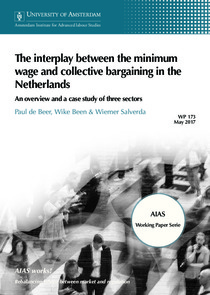The interplay between the minimum wage and collective bargaining in the Netherlands: an overview and a case study of three sectors
"This paper aims to provide a detailed picture in three parts of the statutory minimum wage in the Netherlands that provides a legally minimum level of pay which is binding for all sectors. First, we show how it was legally established in the 1960s and subsequently complemented with an extensiv...
| Main Authors: | , , |
|---|---|
| Institution: | ETUI-European Trade Union Institute |
| Format: | TEXT |
| Language: | English |
| Published: |
Amsterdam
2017
AIAS |
| Subjects: | |
| Online Access: | https://www.labourline.org/KENTIKA-19396860124911140429-The-interplay-between-the-mini.htm |
| _version_ | 1771659902732730369 |
|---|---|
| author | de Beer, Paul Been, Wike Salverda, Wiemer |
| author_facet | de Beer, Paul Been, Wike Salverda, Wiemer |
| collection | Library items |
| description | "This paper aims to provide a detailed picture in three parts of the statutory minimum wage in the Netherlands that provides a legally minimum level of pay which is binding for all sectors. First, we show how it was legally established in the 1960s and subsequently complemented with an extensive set of youth minimum wages, what the rules are that affect its uprating and how these are influenced by trade unions and employers’ associations. We examine how the level and the employment incidence of the minimum wage have evolved since the 1960s to gauge its significance for the development and distribution of wage earnings, including the incidence of low pay. In addition we consider briefly its relationship to personal and household incomes. Secondly, we discuss how the minimum wage relates to collective labour agreements, many of which stipulate wage scales which start at a higher level than the minimum wage. Particular attention is paid to the gap between the lowest wage scales and the minimum wage, which has narrowed considerably since the 1990s under pressure from the government, and how this is reflected in the distribution of wages. Finally, we present the results of three industry-based case studies of the role played by the minimum wage, or not, in the daily practice of collective wage and employment bargaining regarding both the minimum wage itself and the lowest wage scales of collective agreements in three particular industries: metal manufacturing, cleaning and super markets. We end with a brief appraisal of the changes and the future role of the minimum wage." |
| format | TEXT |
| geographic | Netherlands |
| id | 19396860124911140429_4fcb680a511040e29f545a8f62d99a81 |
| institution | ETUI-European Trade Union Institute |
| is_hierarchy_id | 19396860124911140429_4fcb680a511040e29f545a8f62d99a81 |
| is_hierarchy_title | The interplay between the minimum wage and collective bargaining in the Netherlands: an overview and a case study of three sectors |
| language | English |
| physical | 89 p. Digital |
| publishDate | 2017 |
| publisher | Amsterdam AIAS |
| spellingShingle | de Beer, Paul Been, Wike Salverda, Wiemer minimum wage collective bargaining case study cleaning metalworking industry supermarket The interplay between the minimum wage and collective bargaining in the Netherlands: an overview and a case study of three sectors |
| thumbnail | https://www.labourline.org/Image_prev.jpg?Archive=131791395997 |
| title | The interplay between the minimum wage and collective bargaining in the Netherlands: an overview and a case study of three sectors |
| topic | minimum wage collective bargaining case study cleaning metalworking industry supermarket |
| url | https://www.labourline.org/KENTIKA-19396860124911140429-The-interplay-between-the-mini.htm |

